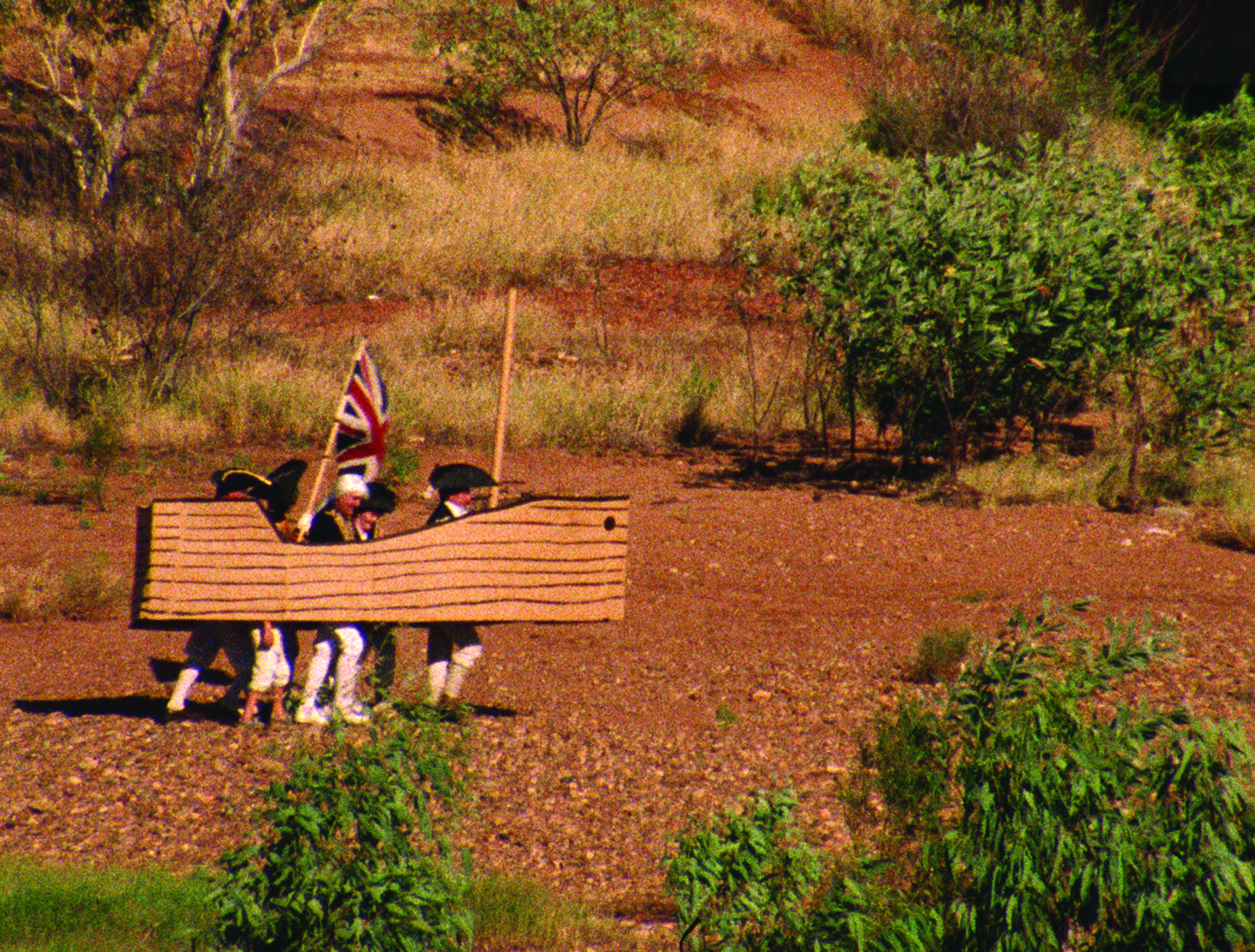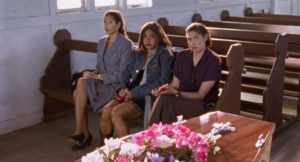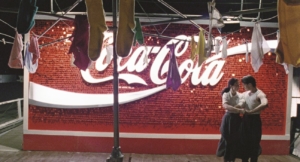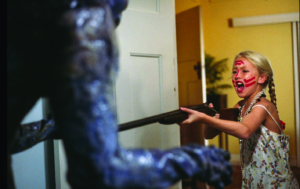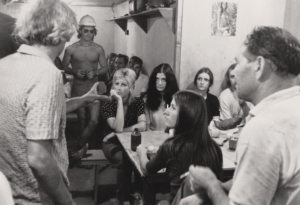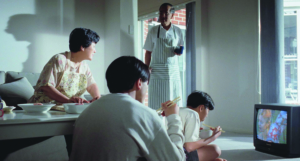THE NFSA RESTORES COLLECTION: PART 59
It took the Bicentenary to do it, berated, ballyhooed, argued about as an expensive irrelevance – yet it worked. It made us think about what it means to be Australian.
– Janet Hawley, Tony Hewett and David Monaghan[1]Janet Hawley, Tony Hewett & David Monaghan, ‘Pomp and Protest as Sydney Celebrates the Bicentenary’, The Sydney Morning Herald, 27 January 1988, available at <https://www.smh.com.au/national/30-years-on-pomp-and-protest-as-sydney-celebrates-the-bicentenary-20180126-h0optp.html>, accessed 16 December 2022.
The problems that were created out of the arrival of the First Fleet are still very much the problems that we experience today: dispossession; poverty; second-rate citizenship […] We want to bring that to the world[’s] attention […] This is a year of mourning, but it’s also a celebration of survival, because we’ve come through a genocide that’s been so vicious and so intense that it’s amazing that we’ve survived. We’re the oldest living culture in this world, and we’re proud of it.
– Linda Burney, in Australia Daze
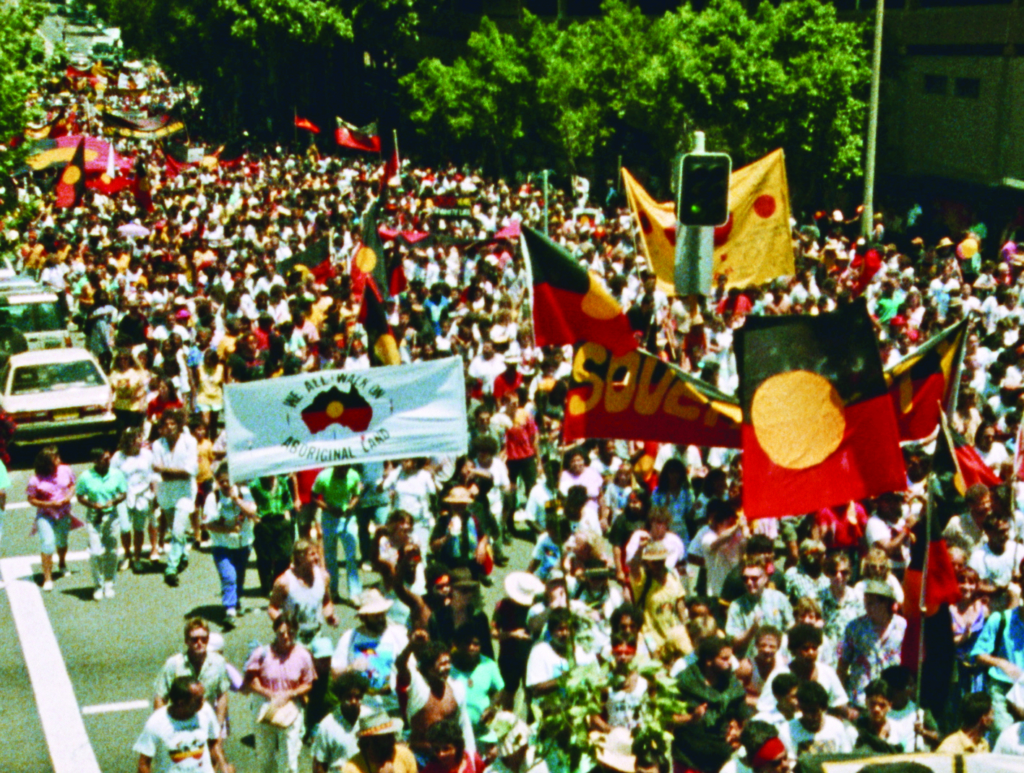
Let’s lend a hand
And show the world
How great we all can be.
All those years
Of sweat and tears,
It’s our Bicentenary.
If you lived in Australia in the late 1980s and watched television, chances are you will have heard these lyrics. In fact, their rather conceited call to arms was almost impossible to avoid. The Australian Bicentennial Authority (ABA) had been set up in 1980 in order to mark the 200th anniversary of the beginning of European settlement of the continent; and the song in which these words appeared, ‘Celebration of a Nation’,[2]The song was composed by Les Gock, with lyrics written by Fran Allen and Tim Phillp. One of the ads in which the song featured is available to watch on the Australian Television Archive’s YouTube channel: see ‘Celebration of a Nation – (Australian Bicentenary Campaign – 1988)’, YouTube, 5 November 2016, <https://www.youtube.com/watch?v=tqkkG2dgpaQ>, accessed 21 December 2022. formed the backdrop to an eponymous marketing campaign aimed at selling the Bicentenary to the Australian public. The fact that the planning took seven years and the budget was more than A$200 million speaks to the gravitas that the celebrations commanded.[3]See Leanne White, ‘The Bicentenary of Australia: Celebration of a Nation’, in Linda K Fuller (ed.), National Days/National Ways: Historical, Political, and Religious Celebrations Around the World, Praeger, Westport, CT & London, 2004, pp. 30–4.
This shamelessly self-congratulatory theme succeeded two earlier iterations: ‘Living Together’ and ‘The Australian Achievement’.[4]ibid. Its upbeat, party-inflected slogan ousted previous attempts to use language that at least nominally acknowledged migrant and First Nations Australians. The theme attempted to marshal the illusion of a unified cultural hegemony, one predicated on acceptance of the mythology surrounding the supposed ‘birth’ of the Australian nation. This branding was met with derision by First Nations activists, some of whom mocked its insular navel-gazing by renaming the theme ‘Masturbation of the Nation’.[5]See Gary Foley, ‘The Sydney Morning Herald and Representation of the 1988 Bicentennial’, The Koori History Website Project, May 1997, <http://www.kooriweb.org/foley/essays/pdf_essays/the%20smh%20and%201988.pdf>, accessed 20 August 2022.
Pat Fiske’s documentary Australia Daze (1988) locates itself at the very centre of this shifting, highly contested landscape. Filmed entirely during the twenty-four hours of the day of the Bicentenary, 26 January 1988 (also the country’s national public holiday, Australia Day), it offers an astonishingly lucid ‘state of the nation’ snapshot, taking in a variety of perspectives, ethnicities, social milieus, ages and locations. The film surveys a rich spectrum of experiences, and its subjects offer contrasting ideological perspectives about what it means to be Australian. In order to ‘take the temperature’ of a diverse cross-section of the Australian public, the filmmakers asked the subjects a range of questions, covering topics such as: What does it mean to be an Australian, or to be living in Australia? Why do many Aboriginal people perceive this event with a sense of mourning? What is good about Australia, and what needs changing? Is multiculturalism working, and is our treatment of migrants fair?
The film is a powerful sociocultural artefact and time capsule that invites its viewers – then and now – to reflect on how far (or how little) we have progressed as a nation, particularly with respect to our relationship with the past.
In order to achieve such a technically ambitious project, Fiske directly oversaw a team of sixteen filmmakers shooting in different locations around the country, while a number of other crews (including three from the ABC) filmed further footage that the team had access to;[6]See Tina Kaufman & Gillian Leahy, ‘Interview with Pat Fiske’, Metro, no. 127/128, 2001, p. 70. around twenty-eight camera crews were involved in the project in total.[7]See Pat Fiske, ‘Pat Fiske on Australia Daze: The Making of a Landmark Documentary’, National Film and Sound Archive of Australia website, 26 January 2021, <https://www.nfsa.gov.au/latest/director-pat-fiske-australia-daze-1988>, accessed 10 May 2022. Australia Daze mines the observational documentary form to powerful effect, notably juxtaposing the viewpoints of First Nations activists and their allies with those of well-heeled pleasure seekers, rural Australians with city dwellers, and Anglo-Australians with first- and second-generation immigrants. The film is a powerful sociocultural artefact and time capsule that invites its viewers – then and now – to reflect on how far (or how little) we have progressed as a nation, particularly with respect to our relationship with the past.
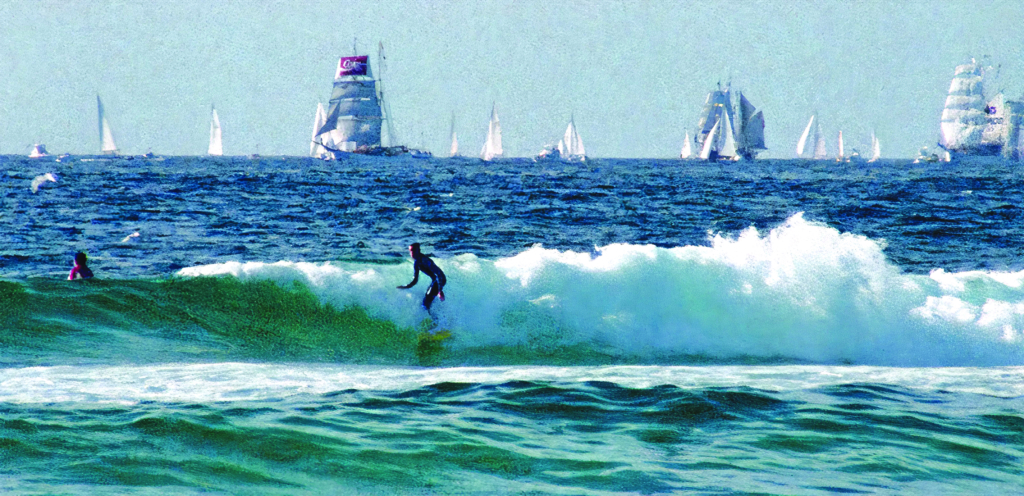
The attitudes and values recorded in Australia Daze traverse the full spectrum from progressive political engagement to casual racism – and, perhaps most disturbingly of all, commentary reflecting a backward Australianness born of privileged ignorance. In many ways, Fiske’s documentary might be considered a worthy companion piece to Wake in Fright (Ted Kotcheff, 1971), the film that most famously interrogated the dark underside of the ‘happy-go-lucky’ Australian stereotype.[8]On release, Wake in Fright was apparently too confronting for many Australian viewers, as its poor domestic box-office return indicates. Actor Jack Thompson recalls that ‘people ran screaming from the theatre, saying “That’s not us.”’ Thompson, quoted in Toni O’Loughlin, ‘Oz Wises Up to Its Horror Heritage’, The Guardian, 19 June 2009, <https://www.theguardian.com/film/2009/jun/19/wake-in-fright-horror-film>, accessed 10 September 2022.
While Wake in Fright is a work of fiction drenched in stylistic excess, Australia Daze offers the relative verisimilitude of its documentary form and authentic subjects; and while Kotcheff’s film is now widely regarded as an artistic masterwork,[9]See Nicholas Godfrey, ‘“That’s Not Us”. Wake in Fright at 50, a Portrait of an Ugly Australia That Became a Cinema Classic’, The Conversation, 4 May 2021,
<https://theconversation.com/thats-not-us-wake-in-fright-at-50-a-portrait-of-an-ugly-australia-that-became-a-cinema-classic-159221>, accessed 21 December 2022. the comparatively candid and undiluted sensibility of Fiske’s documentary offers a vision of the nation that is arguably even more confronting. Framed in this way, Australia Daze is likely to produce an equally uneasy response from many Australian viewers, despite the time that has elapsed since its production. A more contemporary companion piece to Fiske’s documentary might be Friends and Strangers (James Vaughan, 2021), which uses comedic tropes to pursue the cultural displacement that emerges from white Australia’s failure to reckon with its brutal past. Like Australia Daze, Vaughan’s film makes prominent use of Sydney’s coastline as a troublingly symbolic site of convergence between the country’s past and present.[10]See Eileen Jones, ‘Unlucky Country: Malediction and Middle-class Malaise in James Vaughan’s Friends and Strangers’, Metro, no. 210, 2021, pp. 10–5, available at <https://metromagazine.com.au/unlucky-country/>, accessed 20 December 2022.
Addressing ‘a lost opportunity’: Developing Australia Daze
As its title suggests, Australia Daze was conceived as a response to the perceived superficiality of the Bicentenary. After an earlier satirical production by independent director Curtis Levy had its promise of funding revoked by the ABA due to the political nature of the project,[11]Fiske, op. cit. Fiske and fellow documentarian Dennis O’Rourke[12]Although O’Rourke soon stepped away from the production to pursue other projects, he still served as one of Australia Daze’s segment directors (per the film’s press kit, recording the footage of the ‘beer drinking and piano smashing competition’ in Alice Springs). See ‘Production Notes’, in Australian Film Institute, Australia Daze press kit, 1988, p. 3. See also Kaufman & Leahy, op. cit., pp. 69–70. developed the idea for what would become Australia Daze, and managed to attract initial funding from the Australian Film Commission, the ABC and British broadcaster Channel 4.[13]Kaufman & Leahy, ibid. As Fiske recounts,
We […] were all quite disturbed about the way it was being promoted – all razzamatazz and total celebration. There didn’t seem to be any soul-searching or reflection of where Australia was at, where Australia could be and what could be changed for the better. It felt like a lost opportunity![14]Fiske, op. cit.
This desire to engage with the Bicentenary with greater nuance and depth was emblematic of a growing dissatisfaction within some parts of Australian society. The sustained marketing and media focus leading up to 26 January1988 had inevitably sparked conversations about what this date meant for ‘modern’ Australia, and about the significance of the arrival of the First Fleet for First Nations Australians. It was around this time that the activist term ‘Invasion Day’ began to slowly bleed into the political discourse as an alternative term for Australia Day,[15]See Kate Darian-Smith, ‘Australia Day, Invasion Day, Survival Day: A Long History of Celebration and Contestation’, The Conversation, 26 January 2017, <https://theconversation.com/australia-day-invasion-day-survival-day-a-long-history-of-celebration-and-contestation-70278>, accessed 20 December 2022. and that the issue of native land entitlement was brought into sharper relief, becoming part of the broader cultural conversation.[16]See ‘Mabo Decision’, National Museum of Australia website, updated 16 November 2022, <https://www.nma.gov.au/defining-moments/resources/mabo-decision>, accessed 21 December 2022. It was clear that the ahistorical construct of terra nullius – the assertion that the land was unoccupied when the British arrived to claim it – was becoming harder and harder to live with for some sections of the Australian population.
Further fuelling conflicting ideological viewpoints about the day was a widely held view that the ABA’s activities were a waste of taxpayer money,[17]White, op. cit., p. 31. particularly in light of the high rate of poverty in the country at the time.[18]See Peter Saunders & George Matheson, ‘An Ever-rising Tide? Poverty in Australia in the Eighties’, The Economic and Labour Relations Review, vol. 2, no. 2, December 1991, pp. 143–71. Yet this inconvenient reality was at odds with the celebratory tone of the festivities, and was therefore glossed over or ignored entirely by those charged with documenting the occasion. This tension was not lost on historian Tim Rowse, who noted at the time that:
Wealth is held in obscenely unequal proportions in Australia, and those who hold little of it are vast in number, about one household in five living below the recognised ‘poverty line’. In the 1980s their poverty in income has been aggravated by their increasing difficulty in getting the health, housing and educational services they need […] The failure of Australia, like other Western nations, to achieve social justice should surely be a major topic in the nation’s history.[19]Tim Rowse, ‘“… Fallen Among Gentlemen”: A Memoir of the Bicentennial History Project’, Australian Historical Studies, vol. 23, no. 91, 1988, p. 121.
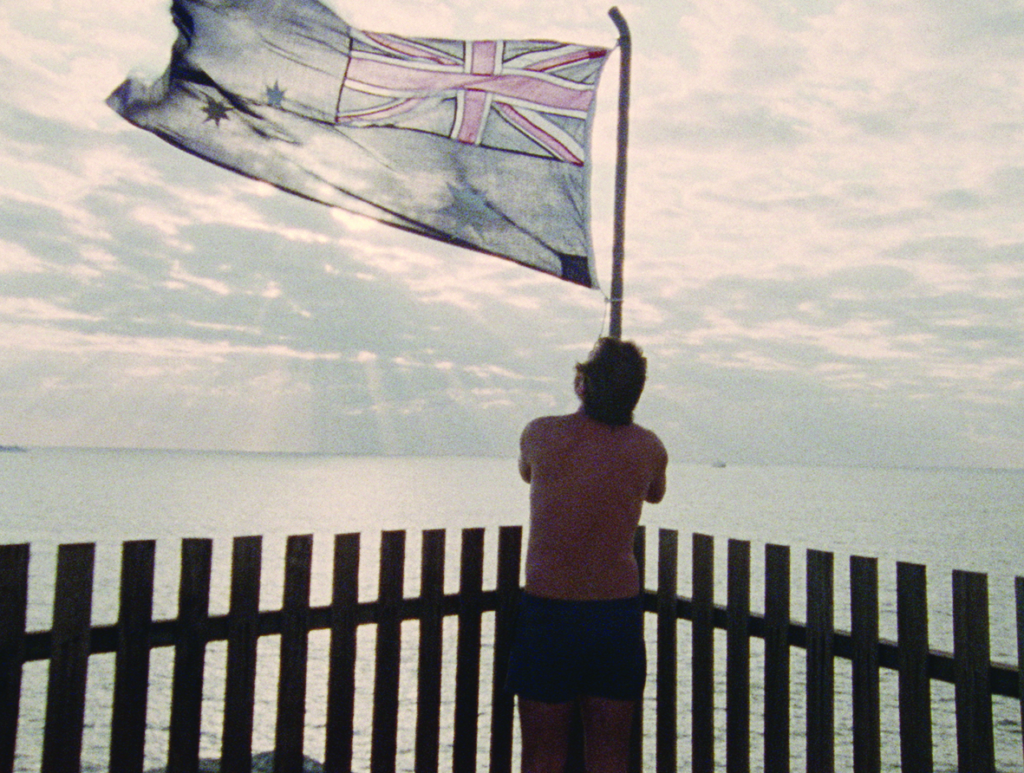
While the issue of poverty is certainly not a specific focus of Australia Daze, the film’s juxtaposition of wealthy, middle, working and unemployed classes illustrates a stark imbalance in the division of wealth. The film’s editing patterns frequently undermine the credibility of the official commentary on Australian identity being peddled by the ABA. This extends to the popular cultural mythology of a ‘fair go’ for all:[20]See Peter Saunders, ‘What Is Fair About a “Fair Go”?’, Policy, vol. 20, no. 1, Autumn 2004, available at <https://www.cis.org.au/wp-content/uploads/2015/04/images/stories/policy-magazine/2004-autumn/2004-20-1-peter-saunders.pdf>, accessed 20 December 2022. we see then prime minister Bob Hawke waxing lyrical about Australia’s supposed egalitarianism: ‘There’s no hierarchy of class in this country,’ he declares. ‘Everyone […] has got as much right as anyone else.’ Yet these claims are repeatedly undercut by the progression of the documentary’s subjects, including two down-and-out men who have no interest in the Bicentenary celebrations. We watch them sitting and smoking in a park until the shops are open for them to buy booze. ‘Just an ordinary day […] That’s all it is, mate!’ is how one sums up the ‘great day’. The superficiality of the glossy veneer of Sydney Harbour is juxtaposed with a flock of hungry birds hoping for an errant crumb from the men. TV presenter Kerri-Anne Kennerley, in full superlative Bicentenary mode, is heard in voiceover telling her viewers that they have ‘a box seat for what promises to be an unprecedented sight on what must be one of the most spectacular harbours in the world’.
Fiske’s ironic undercutting of such generic commentary is often poignant, but never didactic or preachy. The director and her collaborators set out to maintain a position of what John Hughes, one of the documentary’s many segment directors, describes as ‘ironic distance’. In Hughes’ opinion, Australia Daze offers ‘an implicit critique via montage […] a liberal critique inviting the spectator to judge for themselves’.[21]John Hughes, ‘Australia Daze (Pat Fiske, 1988): Questioning Nationhood’, Senses of Cinema, no. 88, <https://www.sensesofcinema.com/2018/cteq/australia-daze-pat-fiske-1988-questioning-nationhood/>, accessed 20 December 2022.
While the documentary’s tight twenty-four-hour production framework, with its spotlight on people participating in ‘cultural’ activities or protests, emphasises people’s sense of connectedness with – or, in some cases, dislocation from – their communities, it also showcases the dramatic variations in their modes of engagement. These contrasts are illuminating, not only capturing religiously, racially and geographically inflected responses to the Bicentenary but also hinting at the divisive influences of wealth and class in Australia. In this way, Australia Daze is a powerful barometer of the attitudes and social structures that underpin Australian society. It offers us a compelling, unnerving and frequently mortifying glimpse at a country grappling with an identity crisis and attempting to reconcile the notion of the ‘Lucky Country’[22]In the sense popularly employed by politicians, as opposed to that intended by cultural critic Donald Horne in his book of the same name. For more on the origin of this phrase, see Jon Donnison, ‘Is Australia Still the Lucky Country?’, BBC News, 31 October 2014, <https://www.bbc.com/news/world-australia-29844752>, accessed 20 December 2022. with its brutal colonial history.
Australia Daze includes snippets of television and radio coverage from the day, utilising footage from the ABC as well as commercial stations. It was shot mostly on 16mm by independent filmmakers stationed at locations across the country; each was charged with capturing the activities, thoughts and attitudes of a particular group of people. The result is a kind of living snapshot, textured by the very specific contours of place and time. By intercutting such a wide range of people and stories, the film is not just an observational documentary but a kind of portmanteau work comprising micro-narratives and experiences. As Hughes is keen to emphasise, the portmanteau structure – now part of a familiar cinematic vernacular, particularly in fiction filmmaking – was far less commonplace back in 1988, and thus a formally as well as technically ambitious creative decision on Fiske’s part.[23]Hughes, op. cit. Indeed, the accumulated material took a staggering seven eleven-hour days just to view. Editors Denise Haslem and Tim Litchfield subsequently cut the footage under Fiske’s supervision; this process took a total of nine months to complete.[24]Fiske, op. cit.
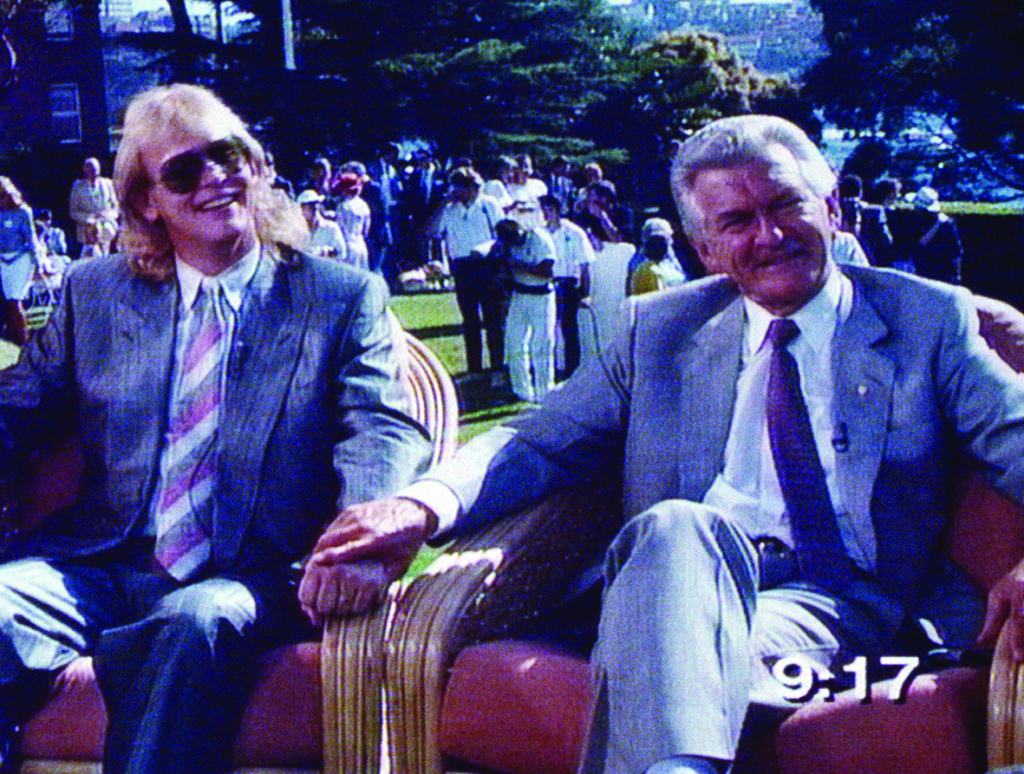
Release, reception and legacy
Australia Daze was given a limited theatrical release in December 1988, initially running at Melbourne’s State Film Theatre and Sydney’s Chauvel Cinema[25]See ‘Australia Dazed on Its Big Birthday’, Tribune, 14 December 1988, pp. 6–7. before screening on the ABC on the evening of 25 January 1989. The film did not attract a great deal of coverage in the press, but was nonetheless well received. Ross Gibson, writing in Filmnews, described Australia Daze as ‘historic’, finding that ‘the mediatised representation of a nation is glimpsed as if by a Martian’ and that the film’s critical argument ‘tugs at the almost distracted viewer at the most surprising junctures’.[26]Ross Gibson, ‘January 26 & All That: Now See the Film’, Filmnews, December 1988, p. 9. Emphasis in original. Elsewhere, David Stratton and Margaret Pomeranz each scored the documentary five stars out of five on The Movie Show, with the latter referring to it as ‘funny, moving, educational, but more importantly totally engrossing’;[27]Margaret Pomeranz, in ‘Australia Daze Review’, The Movie Show, 1989, available at <https://www.nfsa.gov.au/collection/curated/movie-show-australia-daze-review>, accessed 21 December 2022. and Neil Jillett, writing in The Age, declared, ‘This 80-minute comedy – well it is funny most of the time – is an entertaining and at times embarrassing account of how the nation behaved on the great day.’[28]Neil Jillett, cited in Hughes, op. cit. Australia Daze was subsequently recognised at the 1989 Australian Film Institute Awards, where Haslem and Litchfield won the award for best editing of a non-fiction feature.
Following the National Film and Sound Archive of Australia’s digital restoration of the film, Australia Daze returned to the big screen in 26 January 2021, thirty-three years after the footage was first collected.[29]Fiske, op. cit. It was met enthusiastically by audiences of all age groups, from people who were not yet born when the film was shot right though to those who remembered the bicentennial celebrations vividly. A common sentiment among contemporary viewers was the enduring relevance of Australia Daze and its still-topical intersections with the country’s current sociopolitical climate. For some viewers, then and now, the documentary not only portrays the country in an unflattering light but offers an excoriating glimpse into the national psyche itself: one Letterboxd reviewer quips that ‘Midsommar [Ari Aster, 2019] has nothing on the abject folk horror of this sunburnt monstrosity’;[30]Aimee Knight, review of Australia Daze, Letterboxd, 26 January 2022, <https://letterboxd.com/siraimeeknight/film/australia-daze/>, accessed 20 December 2022. while Fiske quotes a viewer’s horrified response to the film’s ABC broadcast: ‘Don’t let this be seen outside Australia, it makes us look like a lot of yobbos.’[31]Cited in Fiske, op. cit.
Australia Daze offers a compelling snapshot of a plethora of issues: homelessness; the nation’s ‘city-centric’ political and media focus; racism; treatment of First Nations people; the appropriateness and significance of 26 January as a national public holiday; and the idea of social ‘echo chambers’ that endlessly reflect people’s existing belief systems back at them, depriving them of a richer spectrum of views. It is a rare and illuminating thing to see such a wide array of opinions about the state of the country.

Many of the key issues for interviewees in the documentary are still up for debate. For example, Australia’s status as a constitutional monarchy was a hot topic in 1988; the royal visit of Prince Charles and Princess Diana was engineered to coincide with the Bicentenary festivities, and Australia Daze captures disparate views about both the royal couple and whether the country should become a republic. Last year’s change of government only reinforces the ongoing relevance of these issues: the federal Labor government has pledged to hold a second republic referendum while they are in office, and plans are underway for a referendum on an Indigenous voice to parliament to be held later this year.[32]See Josh Butler, ‘Voice to Parliament Won’t Give “Special Rights” to Indigenous Australians, Legal Experts Say’, The Guardian, 13 December 2022, <https://www.theguardian.com/australia-news/2022/dec/13/voice-to-parliament-wont-give-special-rights-to-indigenous-australians-legal-experts-say>, accessed 20 December 2022. At the very least, these initiatives signal a desire for progressive cultural conversations and a willingness to reshape the narrative of national identity. And let’s not forget the debate around changing the date: in 2018, radio station Triple J responded to pressure from listeners to reschedule the annual Hottest 100 broadcast, traditionally held on 26 January, as a majority of listeners were uncomfortable with the celebration coinciding with Australia Day.[33]See Paul Donoughue, ‘The Hottest 100 Won’t Be Held on Australia Day Next Year, Triple J Says’, ABC News, 27 November 2017, <https://www.abc.net.au/news/2017-11-27/hottest-100-wont-be-held-on-australia-day-triple-j-says/9197014>, accessed 20 December 2022. A 2021 survey found that 66 per cent of women and 51 per cent of men in Australia were in favour of moving the public holiday to a different date; significantly, younger respondents offered overwhelming support for the idea.[34]Bridget Brennan & Kirstie Wellauer, ‘We’re Changing Our Minds on Australia Day and It’s Happening Rapidly, Australia Talks Reveals’, ABC News, 18 June 2021, <https://www.abc.net.au/news/2021-06-18/australia-day-january-26-views-changing-australia-talks-reveals/100223940>, accessed 20 December 2022. With all that in mind, now seems like a particularly apt time for audiences to revisit Australia Daze.
Formal constraints and opportunities
Although the idea of a ‘time capsule’ record in documentary form is hardly unusual, the singular approach taken by Fiske and her team of filmmakers is worthy of closer examination. Firstly, by being contained within such a specific timeframe, Australia Daze invites us to either endorse or question the broader cultural meaning being ascribed to this particular date; this approach immediately positions us to consider the significance of this so-called ‘birthday’ of European settlement. Fiske places the date front and centre, as do the subjects, who refer to it throughout the documentary. Time progresses in a predictable ‘forward march’: revellers, naysayers and protesters alike are captured against the reassuring backdrop of the passing day as the sun gradually wanes and the shadows take up residence over the Sydney skyline. It’s clear that the film validates the notion of linear time, of moments that move forward in a measurable forward trajectory. This logic extends to the status of Australia Daze as a time capsule:it is a record of the past, of a time that has been lived and can now only be accessed via mediums like film and photography (or, perhaps, the less objective avenue of memory). And yet, in seemingly valorising the date and the time by paying such close attention to it in this way, the film begins to take up a fascinatingly slippery relation to the day in question: Is it complicit in the ‘celebration of a nation’? Is it disdainful? Or does its allegiance land somewhere in between? The reality is that Fiske’s documentary shifts between contradictory poles of identification with ‘Australia Day’ and with the bicentennial milestone. This is further complicated by the film’s exploitation of its tight temporal structure: the film’s editing patterns reinforce the power of the present moment one minute, only to subtly undercut it in another via juxtaposition.
In seemingly valorising the date and the time by paying such close attention to it in this way, the film begins to take up a fascinatingly slippery relation to the day in question.
This contradictory pattern is established in the opening sequence, which introduces the rich tapestry of voices, subjects and locations that the film takes up. Australia Daze begins with time-lapse footage of dawn breaking over Sydney Harbour. There is a sense of anticipation here – that of a child on Christmas morning, impatient for the good bits to start – and of propriety regarding the parameters of time. Yet by being able to be controlled in this way, time is also reduced to something frivolous, something that doesn’t merit our complete attention, and it is in this way that one of the most striking elements of Australia Daze begins to unfold. The film form – its composition and its sequence of unique perspectives – begins to produce a kind of self-reflexive comment on the way that we measure time, as well as the powerful disjuncture between white Australians’ 200-year ‘ownership’ of the continent and the much longer timeline of habitation by Aboriginal and Torres Strait Islander peoples. It is almost as if the film weaponises its time-based form in order to draw attention to the absurdity of such a comparison. Through the film’s embrace of the rigours of a twenty-four-hour shooting schedule, along with the sharpening of its focus to capture narratives anchored in just this one day, a broader narrative emerges about the complexity of our relationship to time: all of the interactions between filmmakers and subjects are wrapped up in clearly delineated sequences of time; and each little measure is itself neatly folded into the film’s ingenious structural framework of individual moments that take place throughout Tuesday, 26 January 1988. The temporal structure is meticulously maintained; the film tracks the day chronologically, from sunrise into the evening. Time is continually signposted within the excerpts of broadcast material from the day, encapsulated by a cheery TV introduction early on in the piece: ‘Good morning, Australia – happy birthday.’

The opening sequence features a soundscape of snippets from talkback radio calls played over the images. We hear a woman waxing lyrical about the day: ‘I’ve never in the whole of my life felt such an overwhelming sense of national pride, and I think that, really, this is just a wonderful thing.’ Her voice is transposed over peaceful images of verdant countryside, followed by footage of white Australian yuppies loading their racing bicycles onto a private speedboat. Another female voice is heard describing the celebrations as feeling like ‘a lot of empty blowing of bags [and] carrying on about achieving 200 years of something … of what?’ We see a man in a country town riding his horse down the street; another image highlights agricultural and farming activity; and footage of a bus adorned with the Aboriginal flag ferrying protesters to Sydney’s March for Freedom, Justice and Hope[35]The main First Nations protest held in Sydney that day, which features prominently in the film. See Melanie Pose, ‘Indigenous Protest, Australian Bicentenary, 1988’, Museums Victoria Collections, 2009, <https://collections.museumsvictoria.com.au/articles/2835>, accessed 21 December 2022. is accompanied by the voice of a First Nations man, whose words could, sadly, just as easily have been recorded yesterday:
Be aware that we have survived, and hopefully start talking amongst yourselves about what the real issues affecting Aboriginal people are – we need a really intelligent, logical, rational debate in white Australia.
Tellingly, the film’s introductory sequence concludes with a slow-motion close-up of the Australian flag billowing, resplendent … and upside down. The inverted Union Jack here immediately signals a challenge to the potency of the colonial narrative; at the same time, it enlists broad humour to orient the spectator, inviting us to take up a critical or even disdainful viewing position in response to some of the narratives and viewpoints we are about to hear. This critical authorial position is most potently evident in the film’s repeated emphasis on the Redfern Park protests and the voices of Aboriginal resistance, as well as those of non-Indigenous allies.
Humour forms an essential part of the film’s meticulous composition, and is often employed as a device for softening the colonial narratives that are crudely endorsed by some of the subjects. For example, we see a patriotic white Aussie bloke whose backyard overlooks the bay enthusing about his planned party and boasting about the view he will have of the tall ships later in the day. When asked about the Aboriginal protests, however, he is indignant: ‘We’ve got one of the best countries in the world! How can you protest about that? […] It’s the best country in the world. Anything you want to do, you can do.’ His commentary follows a cutaway to a neighbouring cliff face where a couple are lazily copulating, as though neither can be particularly bothered to fully commit.
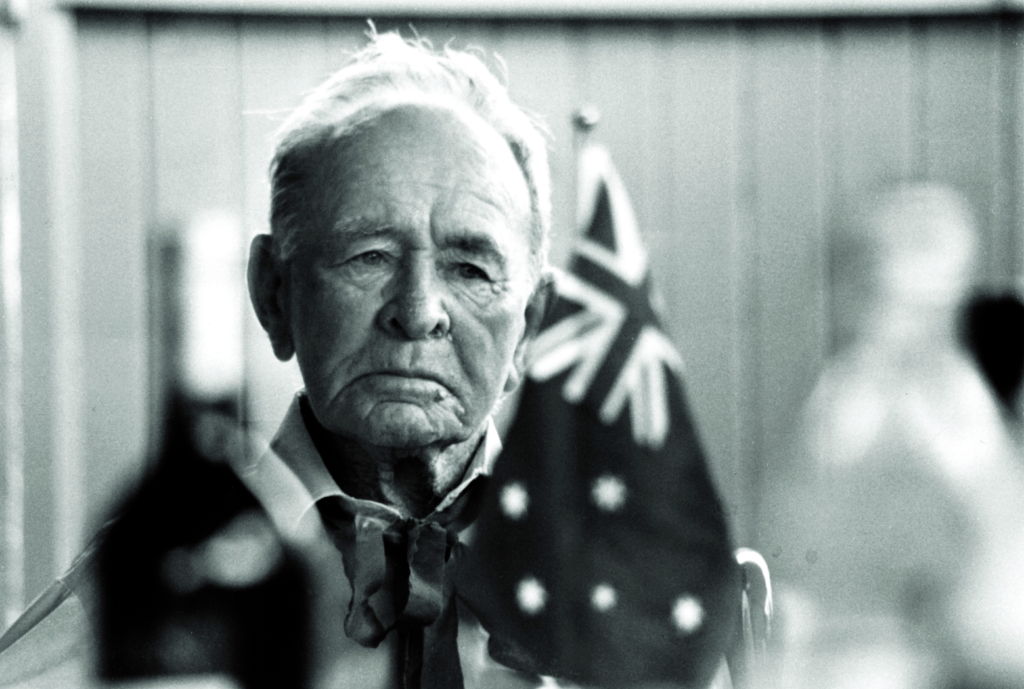
Australia Daze’s juxtaposition of discordant views about the date, in combination with the film’s diegetic and stylistic fixation with time, begins to evoke a creeping awareness of time for the spectator. It becomes possible to discern some of the limitations of fixed temporal concepts such as ‘past’ and ‘future’, when the reality that the present and future are informed by the past is too often ignored by hegemonic colonial narratives of nationhood. In this way, the film form gently – and often humorously – rebukes the narrow way in which non-Indigenous Australians engage with time. It also undermines the self-importance of some of the white Australian subjects and, by extension, the value of the Bicentenary celebration itself.
The emphasis placed on this one date and day is mediated by Fiske’s footage of the Sydney protests: an explicit reminder that Australia was occupied for at least 40,000 years[36]While this was a commonly cited time span at the time the documentary was shot, more recent studies have indicated that Indigenous people have inhabited the continent for at least 65,000 years. See Nicholas St. Fleur, ‘Humans First Arrived in Australia 65,000 Years Ago, Study Suggests’, The New York Times, 19 July 2017, <https://www.nytimes.com/2017/07/19/science/humans-reached-australia-aboriginal-65000-years.html>, accessed 20 December 2022. before the First Fleet sailed into Botany Bay. Images of First Nations activists marching with placards bearing slogans such as ‘White Australia has a black history’ and ‘40,000 years doesn’t make a bicentenary’ help to magnify the temporal disparity between the film form documenting this stage-managed ‘day of national pride’ and the timeline of Indigenous history. It’s also worth considering here that, in First Nations cultures, time has traditionally not been perceived as linear. While a detailed explanation of the concept of ‘deep time’ far exceeds the scope of this essay, suffice it to say that it is not measured in the neat little parentheses that non-Indigenous people are accustomed to; instead, past, present and future time may exist simultaneously.[37]See Ann McGrath, ‘“All Things Will Outlast Us”: How the Indigenous Concept of Deep Time Helps Us Understand Environmental Destruction’, The Conversation, 19 August 2020, <https://theconversation.com/all-things-will-outlast-us-how-the-indigenous-concept-of-deep-time-helps-us-understand-environmental-destruction-132201>, accessed 21 December 2022.
Reflecting resistance
The idea of the past bleeding into the present is particularly resonant for Australia’s First Nations population, whose scars of intergenerational trauma can be traced back to that first landing – an event that has been appropriated and encoded by the colonists. This tension is taken up materially by Australia Daze; its formal revelry in the superficiality of chronological, linear time is continually displaced by voices of Aboriginal protesters reminding us that this land was never ceded. Significantly, the length, frequency and duration of scenes of Aboriginal resistance – particularly the Redfern Park protests – take up more of the film’s seventy-five-minute running time than any other footage in the documentary; indeed, five of the film’s twenty-eight crews were assigned to this one event.[38]See Damien Parer, ‘Curator’s Notes’, ‘Australia Daze (1988)’, Australian Screen, <https://aso.gov.au/titles/documentaries/australia-daze/notes/>, accessed 21 December 2022. One result of the crosscutting of those images with shorter segments that privilege spectacle (the spectator boats jostling for position on the harbour; the fireworks that close the official celebrations) is that the frivolity of the ‘now’ is undermined by the enduring reality of First Nations ownership.
The views and values recorded in Australia Daze were captured several years before the historical and ongoing systemic oppression of First Nations people received any formal recognition by white lawmakers. At this point, the official apology for the Stolen Generations was still twenty years away;[39]See Dylan Welch, ‘Kevin Rudd Says Sorry’, The Sydney Morning Herald, 14 February 2008, <https://www.smh.com.au/national/kevin-rudd-says-sorry-20080214-gds0vu.html>, accessed 21 December 2022. and – perhaps most significantly in the context of Australia Day and its associated cultural narratives of the country’s ‘birthday’ – the Mabo judgement, which recognised Indigenous land rights and officially overturned the doctrine of terra nullius, had not yet been delivered.[40]See ‘Mabo Decision’, op. cit. Within this context, protest and resistance could not have been more important.
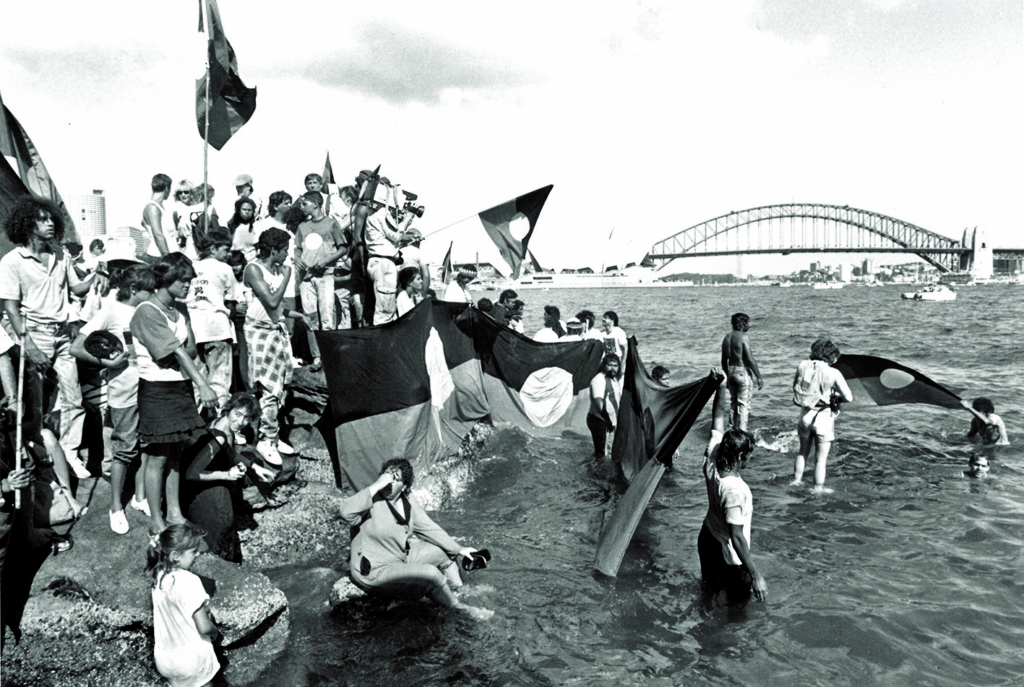
Despite the broad lack of political and social acknowledgement of Indigenous Australians in 1988, there is a satisfying throughline in Australia Daze that cuts against the mainstream complacency of the time and bridges ‘then’ and ‘now’. In fact, watching the film in 2023 magnifies Fiske’s tendency to privilege voices of dissent in Australia Daze; we are granted the capacity to appreciate the ways in which First Nations Australians are continuing to contest the dominant narrative and gradually finding avenues to redress their longstanding representational absence.
Emblematic of the ongoing voice of Indigenous activism is the prominent presence of Linda Burney, now Minister for Indigenous Australians, who appears in the documentary as one of the organisers of the March for Freedom, Justice and Hope; in several pieces to camera, she speaks out about the perversity of commemorating the Bicentenary. It is significant that Burney has successfully transitioned from the young activist we see in the film into a politician who has, through becoming the first Aboriginal woman to ever be elected to the House of Representatives,[41]See ‘Election 2016: Linda Burney Wins Barton, Becomes First Indigenous Woman Elected to House of Representatives’, ABC News, updated 3 July 2016, <https://www.abc.net.au/news/2016-07-02/election-2016-linda-burney-declares-victory-seat-of-barton/7563952>, accessed 21 December 2022. finally penetrated the deep-rooted fortress of Australian government. Her achievement also serves to highlight the overwhelming lack of Indigenous representation in government, and the work still to be done.
Speaking last year about the planned referendum on establishing an Indigenous voice to parliament, Burney summarised its goals:
It’s all about getting clear advice on policies, legislation and programmes that affect First Nations people. It’s about making sure that the outcomes that are so dreadful for Aboriginal people now don’t continue to be […] dreadful.[42]Linda Burney, quoted in Ellie Dudley, ‘Linda Burney Knows Referendums Usually Fail, Here’s Her Plan’, The Oz, 7 July 2022, <https://www.theaustralian.com.au/the-oz/news/linda-burney-knows-referendums-usually-fail-heres-her-plan/news-story/32a05d0b9e59307a29a66169da8f14cd>, accessed 21 December 2022.
The disparity of these outcomes is stark. In 2021, Aboriginal and Torres Strait Islander people comprised 30 per cent of the country’s prisoners, despite making up just 3.2 per cent of the national population;[43]Australian Bureau of Statistics, ‘Prisoners in Australia’, 9 December 2021, <https://www.abs.gov.au/statistics/people/crime-and-justice/prisoners-australia/latest-release>, accessed 21 December 2022. suicide rates are estimated to be a staggering 40 per cent higher for First Nations people than they are among the non-Indigenous population;[44]Victorian Government Department of Health, ‘Suicide Risk and Aboriginal People’, 29 May 2015, <https://www.health.vic.gov.au/practice-and-service-quality/suicide-risk-and-aboriginal-people>, accessed 21 December 2022. and there is a stark life-expectancy gap between First Nations Australians and their non-Indigenous counterparts of 8.6 years for men and 7.8 years for women.[45]Closing the Gap Information Repository, Australian Government Productivity Commission, ‘Socioeconomic Outcome Area 1: Aboriginal and Torres Strait Islander People Enjoy Long and Healthy Lives’, <https://www.pc.gov.au/closing-the-gap-data/dashboard/socioeconomic/outcom-area1>, accessed 21 December 2022. Institutional racism remains endemic in the structures of Australian society, and Indigenous Australians are particularly marginalised and discriminated against.[46]See ‘Does Australia Have a Racism Problem?’, Amnesty International website, 6 October 2021, <https://www.amnesty.org.au/does-australia-have-a-racism-problem-in-2021/>, accessed 21 December 2022. And yet, despite these profound systemic and cultural obstacles, it is Burney who endures beyond the frames of Australia Daze’s ‘time capsule’ of the past more than any other Australian public figure we see on screen. While personalities like Hawke, Kennerley, and radio presenters John Doyle and Greig Pickhaver (better known by their respective monikers ‘Roy Slaven’ and ‘HG Nelson’) are all either firmly bound to the Australia of that era or much less visible today than they once were, Burney still holds a significant place in public life thirty-five years on. For the contemporary viewer, Burney’s presence thus symbolically ruptures the finality of the time capsule, and at least glancingly reinstates a more fluid measure of temporality. When viewed through this lens, Australia Daze signals the possibility of authentic reconciliation, of the collapse of binary ‘us’ and ‘them’ constructs, and of mutual cultural understanding.
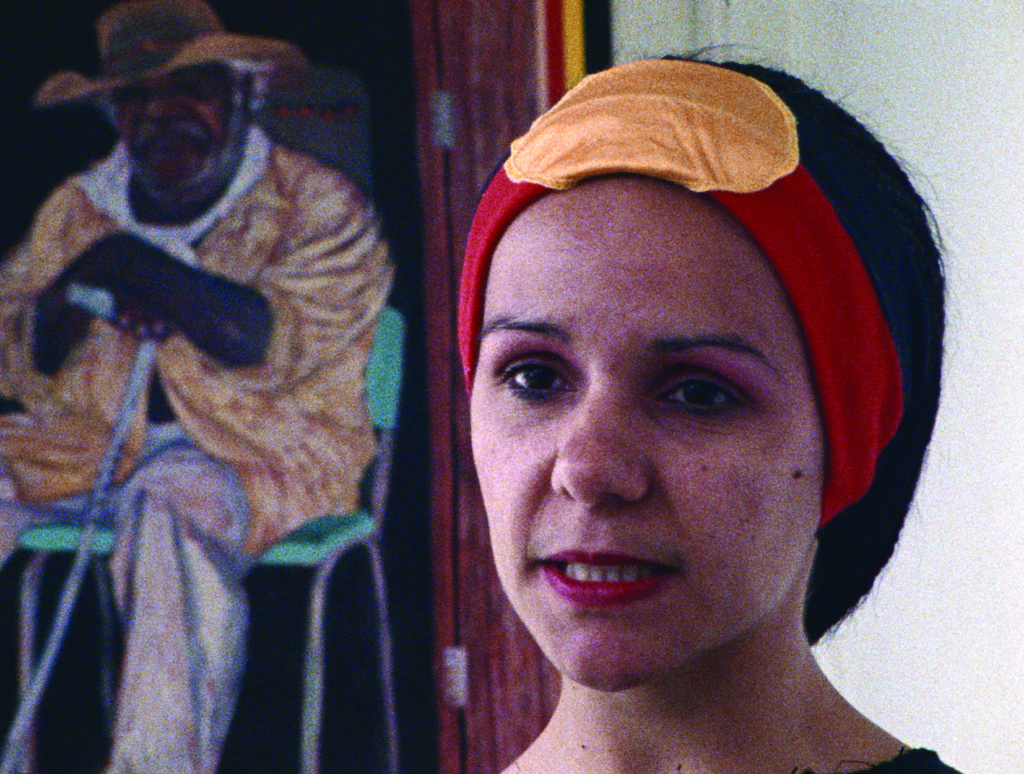
Temporal sidesteps
This idea of a shared and grounded perspective is subtly taken up in the film form when Fiske offers us brief moments of respite from the frenzied pace of the Bicentenary celebrations. In one sequence, a pair of identical twin girls enjoy a paddle in the waves at a Sydney beach; we hear the sound of waves rushing in and out and the delighted squeals of children bodysurfing in the background. This interlude recalibrates the film’s pace and rhythm: for a welcome moment, the barrage of self-important opinions ceases and we are left only with the simple joy of children, ocean, sun and sand; the simple magic of an Australian summer reminds us of what connects us, transcending both politics and time. In short-circuiting the film’s manic forward momentum, this sequence sidelines politics in favour of the beauty of the landscape, its languid rhythm inviting full sensory immersion in place.
Soon after this passage, a wildly euphoric montage is interrupted by another interlude that foregrounds a connection to the Australian landscape. Initially, we watch an accumulation of activity including punters madly cheering on racehorses, teenagers hurtling towards the camera on skateboards, an egg-and-spoon race, and even a sprint featuring lawnmowers and garbage bins. The music is all big-band pomp and ceremony, and the sense conveyed is that these folks are united in sharing their respective activities and their celebration of what the day represents. Then, all of a sudden, the film cuts to the relative quietude of a Mount Isa farm, where two drovers sit on the ground drinking tea; their commentary is accompanied only by the twittering of birds, and the men are momentarily framed from a respectful distance by a relatively static handheld shot. Following the hive of noise and motion in the previous sequence, their lack of movement registers powerfully.
We are subtly reminded of the enduring presence of the Australian continent and, by extension, the relative insignificance of a 200-year ‘birthday’ when compared with tens of thousands of years of First Nations history.
The two men – legendary drover Noel ‘Pic’ Willetts[47]See Steven Schubert, ‘Five Droving Legends Ride from Camooweal to Kununurra’, ABC Rural, updated 3 June 2011, <https://www.abc.net.au/news/rural/2011-06-01/five-droving-legends-ride-from-camooweal-to/6184856>, accessed 21 December 2022. and a fellow herdsman named Bob – are seen throughout the film, their presence and that of the landscape that surrounds them offering a counterpoint to the film’s otherwise Sydney-centric coverage. Segment director Dick Marks has explained that his intention was to ‘give a voice to the bush’:
Willetts and his mate couldn’t give a rats [sic] arse that it was Australia’s biggest birthday celebration and he did what he did almost every other day of his life [… which was to] muster. Willetts offered us the wisdom of the bush, forged from thousands of hours spent alone in the saddle, cocooned in an envelope of bellowing and dust.[48]Dick Marks, quoted in James Cunningham, ‘A Behind-the
-scenes Look at Recently Restored 1988 Documentary Australia Daze’, Australian Cinematographer, 1 June 2021, <https://acmag.com.au/2021/06/01/australia-daze/>, accessed 21 December 2022.
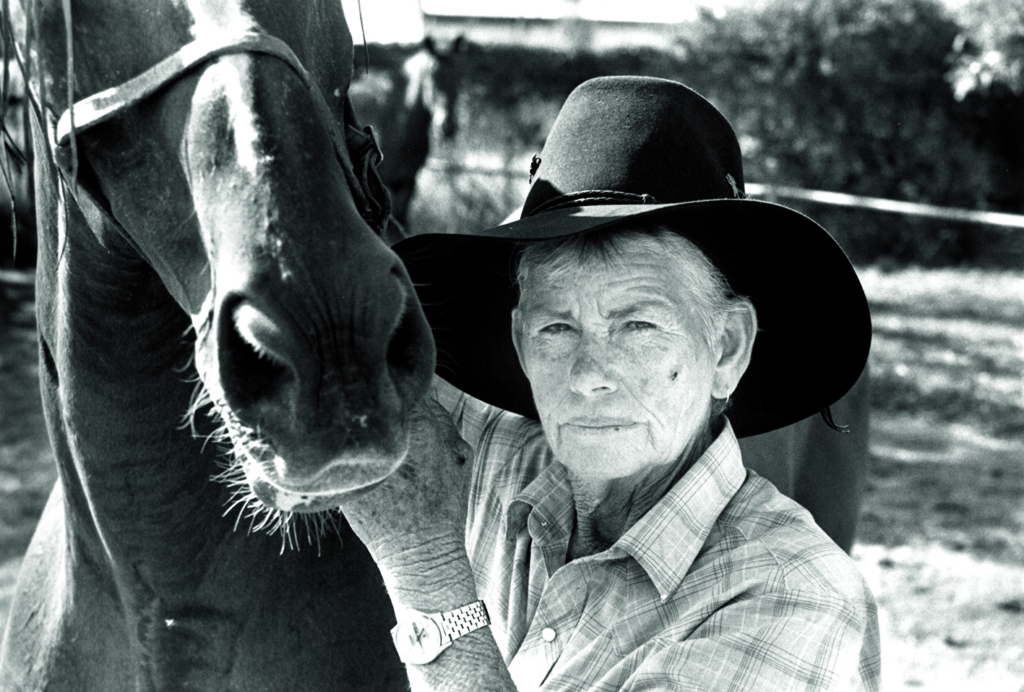
Mirroring the languid pace of the beach sequence, the Mount Isa segments signal a distinct temporal shift. Significantly, the drovers are not at all invested in the Bicentenary: Willetts admits that he has never had ‘much interest in that sort of thing […] Dunno what’s going on half the time.’ Instead, like the twin girls paddling in the ocean, their primary connection is with the land. The men agree that they have probably been ‘left behind’, though neither seems particularly concerned by that fact. When asked about the dispossession of Indigenous Australians, Willetts expresses profound respect for their resourceful land management:
I think they had a good system, really – I like their system. Because I tell you what, the white man, where he would have wiped himself out, the Aboriginal would have been lived here for another 40 million years […] but the white man, he won’t last long. If he goes another 200 years, he’d be lucky.
It’s interesting that, in disrupting the frenzied pace of the chronological, dawn-to-dark coverage of 26 January 1988, these little moments privilege the Australian landscape. It’s also notable that they are set outside the Bicentennial political agenda, so that they seem to transcend the rigid parameters of time that Australia Daze is otherwise boxed within. Temporal transitions such as these exemplify the film’s slippery relationship with the significance of the date. On the one hand, there is undeniable excitement and a clear sense of community on display in the carnival sequences; the camera tracking along with the forward momentum of the egg-and-spoon race, for instance, seems to endorse this kind of celebration. On the other, the contrast of human movement and sound with the majestic stillness and diegetic sounds of the Mount Isa bush complicates this relationship with the Bicentenary. Through juxtaposition and temporal shifts, we are subtly reminded of the enduring presence of the Australian continent and, by extension, the relative insignificance of a 200-year ‘birthday’ when compared with tens of thousands of years of First Nations history.

Swimming against the tide
Fiske and her editors ensure that resistance to the official colonial narrative is offered throughout Australia Daze. The juxtaposition of opinions, locations and subjects offers wideranging perspectives, but the placement of footage retains a discrete focus on the position of Australia’s Indigenous population. A rural community’s float rolls past the camera complete with several performers in blackface, presumably there to take part in a re-enactment of the arrival of the First Fleet. But the crew also captures an elderly white woman who has climbed onto her suburban rooftop to raise the Aboriginal flag. ‘It’s just a token of acknowledgement – we’ve still got a long way to go, and [this is] just a small one-person effort,’ she explains.
This pattern is repeated when we see an affluent white Australian man skippering a boat packed with fellow members of his milieu to watch the spectacle of the re-enactment. In one of the most cringe-inducing interviews in the film, he holds forth on his views on First Nations people:
I have this wish that, when the First Fleet comes past, their anger will subside for a while and they’ll feel happier about it, and get caught up in it […] If you compare it to the other countries that have been overrun by the whites and what they’ve done to their native population[s], I think Aborigines, hopefully, have fared better than many.
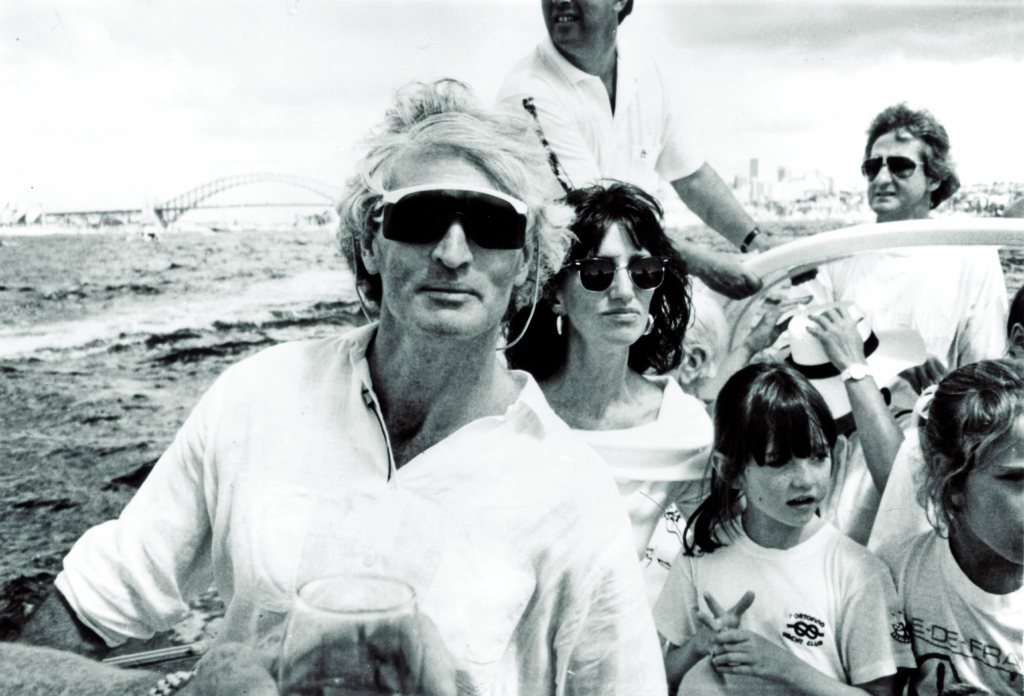
This entitled and embarrassingly ignorant perspective is swiftly followed by footage of the Redfern Park protests. There, we see white and Indigenous activists gathered together, united in the need for greater understanding as well as in their call for truth-telling and for the reality of Australia’s brutal history to be laid bare, not glossed over with celebratory fireworks displays and street parties. It is telling that the final human subject we see in the documentary is an Indigenous dancer in traditional dress: he weaves his way through the crowd, his clapsticks competing with the sound of non-diegetic music, which gets louder and louder until the ceremonial instruments and singing can no longer be heard. When the final credits roll on this astonishing documentary, the film form has absorbed and mediated the tensions at the heart of the Bicentenary celebrations, using the date as a lightning rod for issues that remain just as relevant today.
Select bibliography
‘Australia Dazed on Its Big Birthday’, Tribune, 14 December 1988, pp. 6–7.
Australian Film Institute, Australia Daze press kit, 1988.
James Cunningham, ‘A Behind-the-scenes Look at Recently Restored 1988 Documentary Australia Daze’, Australian Cinematographer, 1 June 2021, <https://acmag.com.au/2021/06/01/australia-daze/>.
Pat Fiske, ‘Pat Fiske on Australia Daze: The Making of a Landmark Documentary’, National Film and Sound Archive of Australia website, 26 January 2021, <https://www.nfsa.gov.au/latest/director-pat-fiske-australia-daze-1988>.
Ross Gibson, ‘January 26 & All That: Now See the Film’, Filmnews, December 1988, p. 9.
John Hughes, ‘Australia Daze (Pat Fiske, 1988): Questioning Nationhood’, Senses of Cinema, no. 88, <https://www.sensesofcinema.com/2018/cteq/australia-daze-pat-fiske-1988-questioning-nationhood/>.
Tina Kaufman & Gillian Leahy, ‘Interview with Pat Fiske’, Metro, no. 127/128, 2001, pp. 64–75.
Damien Parer, ‘Curator’s Notes’, ‘Australia Daze (1988)’, Australian Screen, <https://aso.gov.au/titles/documentaries/australia-daze/notes/>.
PRINCIPAL CREDITS
Year of Release 1988 Length 75 minutes Producer Graeme Isaac Co-producer Pat Fiske Director Pat Fiske Segment Directors Karin Altmann, Mario Andreacchio, Graham Chase, Sharon Connolly, Sue Cornwell, Ruth Cullen, Bernice Daly, Jack Davis, Jim Everett, Jen Feray, Pat Fiske, Martin Goddard, Trevor Graham, John Hughes, Tony Jones, Jeni Kendall, Ned Lander, Dick Marks, Penny McDonald, Dennis O’Rourke, Christine Sammers, Carole Sklan, Tony Steinbrecker, Paul Tait, Gordon Taylor, Jeni Thornley, Nick Torrens, Madelon Wilkins Cinematographers Erika Addis, Ray Argall, Kerry Brown, Philip Bull, Rey Carlson, Jane Castle, Rod Coats, Paul Costello, Ian Cregan, Helen Dallow, Roger Darling, Chris Doig, Jaems Grant, Wayne Harvey, Peta Hill, David Knaus, Peter Kordyl, Dick Marks, Steve Mason, Penny McDonald, Jenny Meany, Catherinne Mraciniak, David Noakes, Dennis O’Rourke, Brendan Shaw, Debbie Stothard, Paul Tait, Leigh Tilson, Paul Turner, John Whitteron Editors Denise Haslem, Tim Litchfield Music Davood Tabrizi Sound Editors Denise Haslem, Mitzi Goldman
Endnotes
| 1 | Janet Hawley, Tony Hewett & David Monaghan, ‘Pomp and Protest as Sydney Celebrates the Bicentenary’, The Sydney Morning Herald, 27 January 1988, available at <https://www.smh.com.au/national/30-years-on-pomp-and-protest-as-sydney-celebrates-the-bicentenary-20180126-h0optp.html>, accessed 16 December 2022. |
|---|---|
| 2 | The song was composed by Les Gock, with lyrics written by Fran Allen and Tim Phillp. One of the ads in which the song featured is available to watch on the Australian Television Archive’s YouTube channel: see ‘Celebration of a Nation – (Australian Bicentenary Campaign – 1988)’, YouTube, 5 November 2016, <https://www.youtube.com/watch?v=tqkkG2dgpaQ>, accessed 21 December 2022. |
| 3 | See Leanne White, ‘The Bicentenary of Australia: Celebration of a Nation’, in Linda K Fuller (ed.), National Days/National Ways: Historical, Political, and Religious Celebrations Around the World, Praeger, Westport, CT & London, 2004, pp. 30–4. |
| 4 | ibid. |
| 5 | See Gary Foley, ‘The Sydney Morning Herald and Representation of the 1988 Bicentennial’, The Koori History Website Project, May 1997, <http://www.kooriweb.org/foley/essays/pdf_essays/the%20smh%20and%201988.pdf>, accessed 20 August 2022. |
| 6 | See Tina Kaufman & Gillian Leahy, ‘Interview with Pat Fiske’, Metro, no. 127/128, 2001, p. 70. |
| 7 | See Pat Fiske, ‘Pat Fiske on Australia Daze: The Making of a Landmark Documentary’, National Film and Sound Archive of Australia website, 26 January 2021, <https://www.nfsa.gov.au/latest/director-pat-fiske-australia-daze-1988>, accessed 10 May 2022. |
| 8 | On release, Wake in Fright was apparently too confronting for many Australian viewers, as its poor domestic box-office return indicates. Actor Jack Thompson recalls that ‘people ran screaming from the theatre, saying “That’s not us.”’ Thompson, quoted in Toni O’Loughlin, ‘Oz Wises Up to Its Horror Heritage’, The Guardian, 19 June 2009, <https://www.theguardian.com/film/2009/jun/19/wake-in-fright-horror-film>, accessed 10 September 2022. |
| 9 | See Nicholas Godfrey, ‘“That’s Not Us”. Wake in Fright at 50, a Portrait of an Ugly Australia That Became a Cinema Classic’, The Conversation, 4 May 2021, <https://theconversation.com/thats-not-us-wake-in-fright-at-50-a-portrait-of-an-ugly-australia-that-became-a-cinema-classic-159221>, accessed 21 December 2022. |
| 10 | See Eileen Jones, ‘Unlucky Country: Malediction and Middle-class Malaise in James Vaughan’s Friends and Strangers’, Metro, no. 210, 2021, pp. 10–5, available at <https://metromagazine.com.au/unlucky-country/>, accessed 20 December 2022. |
| 11 | Fiske, op. cit. |
| 12 | Although O’Rourke soon stepped away from the production to pursue other projects, he still served as one of Australia Daze’s segment directors (per the film’s press kit, recording the footage of the ‘beer drinking and piano smashing competition’ in Alice Springs). See ‘Production Notes’, in Australian Film Institute, Australia Daze press kit, 1988, p. 3. See also Kaufman & Leahy, op. cit., pp. 69–70. |
| 13 | Kaufman & Leahy, ibid. |
| 14 | Fiske, op. cit. |
| 15 | See Kate Darian-Smith, ‘Australia Day, Invasion Day, Survival Day: A Long History of Celebration and Contestation’, The Conversation, 26 January 2017, <https://theconversation.com/australia-day-invasion-day-survival-day-a-long-history-of-celebration-and-contestation-70278>, accessed 20 December 2022. |
| 16 | See ‘Mabo Decision’, National Museum of Australia website, updated 16 November 2022, <https://www.nma.gov.au/defining-moments/resources/mabo-decision>, accessed 21 December 2022. |
| 17 | White, op. cit., p. 31. |
| 18 | See Peter Saunders & George Matheson, ‘An Ever-rising Tide? Poverty in Australia in the Eighties’, The Economic and Labour Relations Review, vol. 2, no. 2, December 1991, pp. 143–71. |
| 19 | Tim Rowse, ‘“… Fallen Among Gentlemen”: A Memoir of the Bicentennial History Project’, Australian Historical Studies, vol. 23, no. 91, 1988, p. 121. |
| 20 | See Peter Saunders, ‘What Is Fair About a “Fair Go”?’, Policy, vol. 20, no. 1, Autumn 2004, available at <https://www.cis.org.au/wp-content/uploads/2015/04/images/stories/policy-magazine/2004-autumn/2004-20-1-peter-saunders.pdf>, accessed 20 December 2022. |
| 21 | John Hughes, ‘Australia Daze (Pat Fiske, 1988): Questioning Nationhood’, Senses of Cinema, no. 88, <https://www.sensesofcinema.com/2018/cteq/australia-daze-pat-fiske-1988-questioning-nationhood/>, accessed 20 December 2022. |
| 22 | In the sense popularly employed by politicians, as opposed to that intended by cultural critic Donald Horne in his book of the same name. For more on the origin of this phrase, see Jon Donnison, ‘Is Australia Still the Lucky Country?’, BBC News, 31 October 2014, <https://www.bbc.com/news/world-australia-29844752>, accessed 20 December 2022. |
| 23 | Hughes, op. cit. |
| 24 | Fiske, op. cit. |
| 25 | See ‘Australia Dazed on Its Big Birthday’, Tribune, 14 December 1988, pp. 6–7. |
| 26 | Ross Gibson, ‘January 26 & All That: Now See the Film’, Filmnews, December 1988, p. 9. Emphasis in original. |
| 27 | Margaret Pomeranz, in ‘Australia Daze Review’, The Movie Show, 1989, available at <https://www.nfsa.gov.au/collection/curated/movie-show-australia-daze-review>, accessed 21 December 2022. |
| 28 | Neil Jillett, cited in Hughes, op. cit. |
| 29 | Fiske, op. cit. |
| 30 | Aimee Knight, review of Australia Daze, Letterboxd, 26 January 2022, <https://letterboxd.com/siraimeeknight/film/australia-daze/>, accessed 20 December 2022. |
| 31 | Cited in Fiske, op. cit. |
| 32 | See Josh Butler, ‘Voice to Parliament Won’t Give “Special Rights” to Indigenous Australians, Legal Experts Say’, The Guardian, 13 December 2022, <https://www.theguardian.com/australia-news/2022/dec/13/voice-to-parliament-wont-give-special-rights-to-indigenous-australians-legal-experts-say>, accessed 20 December 2022. |
| 33 | See Paul Donoughue, ‘The Hottest 100 Won’t Be Held on Australia Day Next Year, Triple J Says’, ABC News, 27 November 2017, <https://www.abc.net.au/news/2017-11-27/hottest-100-wont-be-held-on-australia-day-triple-j-says/9197014>, accessed 20 December 2022. |
| 34 | Bridget Brennan & Kirstie Wellauer, ‘We’re Changing Our Minds on Australia Day and It’s Happening Rapidly, Australia Talks Reveals’, ABC News, 18 June 2021, <https://www.abc.net.au/news/2021-06-18/australia-day-january-26-views-changing-australia-talks-reveals/100223940>, accessed 20 December 2022. |
| 35 | The main First Nations protest held in Sydney that day, which features prominently in the film. See Melanie Pose, ‘Indigenous Protest, Australian Bicentenary, 1988’, Museums Victoria Collections, 2009, <https://collections.museumsvictoria.com.au/articles/2835>, accessed 21 December 2022. |
| 36 | While this was a commonly cited time span at the time the documentary was shot, more recent studies have indicated that Indigenous people have inhabited the continent for at least 65,000 years. See Nicholas St. Fleur, ‘Humans First Arrived in Australia 65,000 Years Ago, Study Suggests’, The New York Times, 19 July 2017, <https://www.nytimes.com/2017/07/19/science/humans-reached-australia-aboriginal-65000-years.html>, accessed 20 December 2022. |
| 37 | See Ann McGrath, ‘“All Things Will Outlast Us”: How the Indigenous Concept of Deep Time Helps Us Understand Environmental Destruction’, The Conversation, 19 August 2020, <https://theconversation.com/all-things-will-outlast-us-how-the-indigenous-concept-of-deep-time-helps-us-understand-environmental-destruction-132201>, accessed 21 December 2022. |
| 38 | See Damien Parer, ‘Curator’s Notes’, ‘Australia Daze (1988)’, Australian Screen, <https://aso.gov.au/titles/documentaries/australia-daze/notes/>, accessed 21 December 2022. |
| 39 | See Dylan Welch, ‘Kevin Rudd Says Sorry’, The Sydney Morning Herald, 14 February 2008, <https://www.smh.com.au/national/kevin-rudd-says-sorry-20080214-gds0vu.html>, accessed 21 December 2022. |
| 40 | See ‘Mabo Decision’, op. cit. |
| 41 | See ‘Election 2016: Linda Burney Wins Barton, Becomes First Indigenous Woman Elected to House of Representatives’, ABC News, updated 3 July 2016, <https://www.abc.net.au/news/2016-07-02/election-2016-linda-burney-declares-victory-seat-of-barton/7563952>, accessed 21 December 2022. |
| 42 | Linda Burney, quoted in Ellie Dudley, ‘Linda Burney Knows Referendums Usually Fail, Here’s Her Plan’, The Oz, 7 July 2022, <https://www.theaustralian.com.au/the-oz/news/linda-burney-knows-referendums-usually-fail-heres-her-plan/news-story/32a05d0b9e59307a29a66169da8f14cd>, accessed 21 December 2022. |
| 43 | Australian Bureau of Statistics, ‘Prisoners in Australia’, 9 December 2021, <https://www.abs.gov.au/statistics/people/crime-and-justice/prisoners-australia/latest-release>, accessed 21 December 2022. |
| 44 | Victorian Government Department of Health, ‘Suicide Risk and Aboriginal People’, 29 May 2015, <https://www.health.vic.gov.au/practice-and-service-quality/suicide-risk-and-aboriginal-people>, accessed 21 December 2022. |
| 45 | Closing the Gap Information Repository, Australian Government Productivity Commission, ‘Socioeconomic Outcome Area 1: Aboriginal and Torres Strait Islander People Enjoy Long and Healthy Lives’, <https://www.pc.gov.au/closing-the-gap-data/dashboard/socioeconomic/outcom-area1>, accessed 21 December 2022. |
| 46 | See ‘Does Australia Have a Racism Problem?’, Amnesty International website, 6 October 2021, <https://www.amnesty.org.au/does-australia-have-a-racism-problem-in-2021/>, accessed 21 December 2022. |
| 47 | See Steven Schubert, ‘Five Droving Legends Ride from Camooweal to Kununurra’, ABC Rural, updated 3 June 2011, <https://www.abc.net.au/news/rural/2011-06-01/five-droving-legends-ride-from-camooweal-to/6184856>, accessed 21 December 2022. |
| 48 | Dick Marks, quoted in James Cunningham, ‘A Behind-the -scenes Look at Recently Restored 1988 Documentary Australia Daze’, Australian Cinematographer, 1 June 2021, <https://acmag.com.au/2021/06/01/australia-daze/>, accessed 21 December 2022. |
